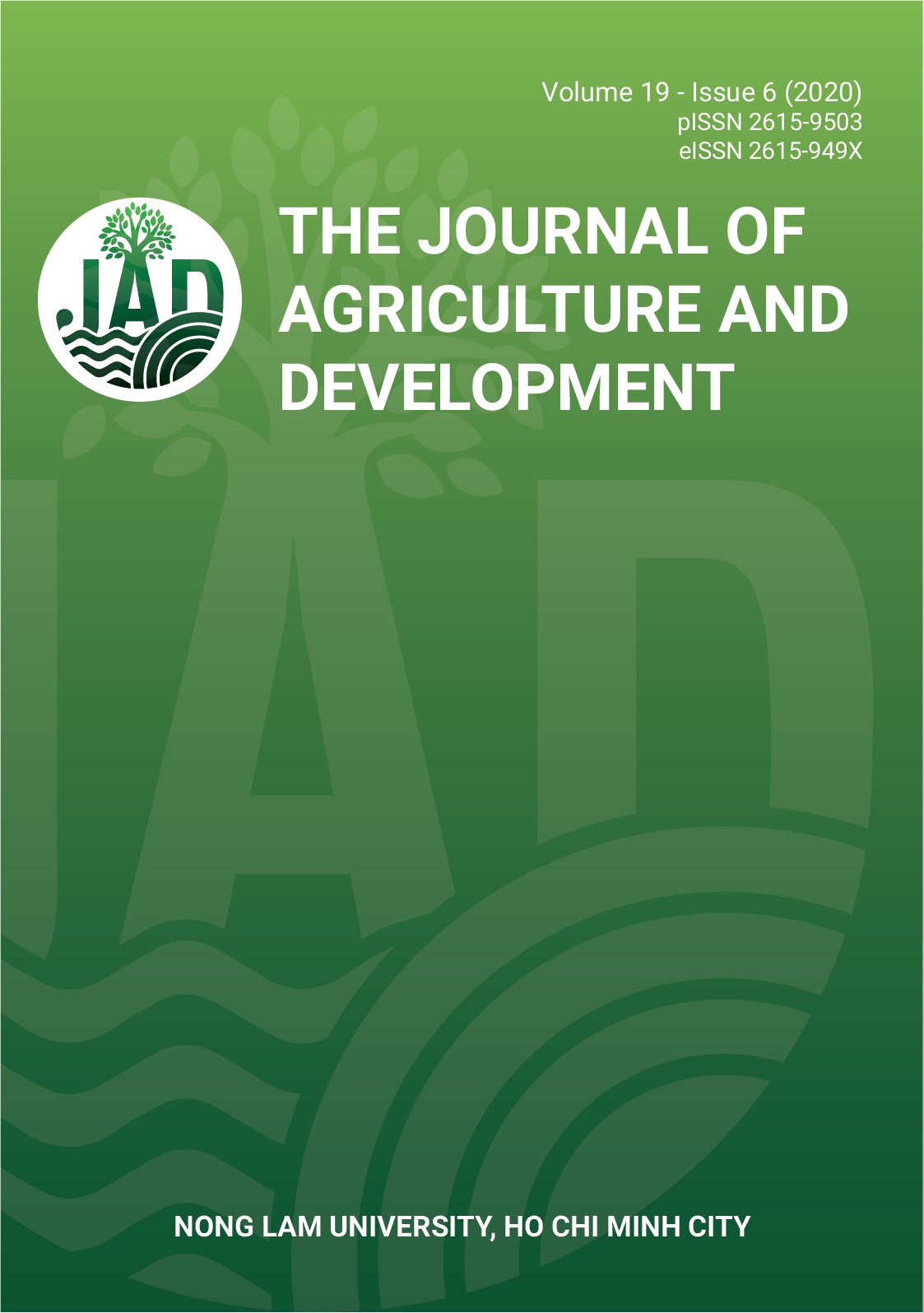Risk factors associated with canine parvovirus disease in dogs: A case-control study
Main Article Content
Abstract
Canine parvovirus type-2 (CPV-2) is one of the most contagious viral agents causing acute enteritis in pups with high rate of morbidity and mortality. The study aimed to investigate the risk factors associated with canine parvovirus (CPV) occurrence in dogs in Ho Chi Minh City, Vietnam. A total number of 132 dogs less than six months of age were recruited in the study and split into two groups: 'CPV diseased dogs' included 44 (33.3%) dogs positive with canine parvovirus confirmed by rapid immuno-migration test, and ‘normal dogs’ consisted of 88 (66.7%) healthy dogs. Results indicated that the unvaccinated dogs had 11.76 times more risk of CPV infection than vaccinated dogs (OR = 11.76, P <0.001). The risk of CPV in dogs raised with others at the same age was 5.01 times (OR = 5.01, P = 0.027) higher than those raised singly. The risk of CPV infection of dogs interacting with neighbour dogs was 3.13 times (OR = 3.13, P = 0.028) higher than the dogs having no contact with other dogs living nearby. Briefly, our study highlights potential factors for CPV disease prevention, especially CPV vaccination is the most important driver affecting the occurrence of parvovirus in young dogs.
Article Details
References
Boone, D., Halligan, S., Mallett, S., Taylor, S. A., & Altman, D. G. (2012). Systematic review: Bias in imaging studies - the effect of manipulating clinical context, re-call bias and reporting intensity. European Radiology 22(3), 495-505. https://doi.org/10.1007/s00330-011-2294-0
Brady, S., Norris, J. M., Kelman, M., & Ward, M. P. (2012). Canine parvovirus in Australia: The role of socio-economic factors in disease clusters. The Veterinary Journal 193(2), 522-528. https://doi.org/10.1016/j.tvjl.2012.01.025
Bukowski, J. A., & Aiello, S. (2011). Description and physical characteristics of dogs-Dog owners-Veterinary manual. Retrieved September 15, 2020, from Description and Physical Characteristics of Dogs - Dog Owners - Veterinary Manual (msdvetmanual.com)
Decaro, N., & Buonavoglia, C. (2012). Canine parvovirus - A review of epidemiological and diagnostic aspects, with emphasis on type 2c. Veterinary Microbiology 155(1), 1-12. https://doi.org/10.1016/j.vetmic.2011.09.007
Glover, S., Anderson, C., Piontkowski, M., & Ng, T. (2012). Canine parvovirus (CPV) type 2b vaccine protects puppies with maternal antibodies to CPV when challenged with virulent CPV-2c virus. Journal of Applied Research in Veterinary Medicine 10(3), 217-224.
Goddard, A., & Leisewitz, A. L. (2010). Canine parvovirus. Veterinary Clinics of North America: Small Animal Practice 40(6), 1041-1053. https://doi.org/10.1016/j.cvsm.2010.07.007
Hoang, M., Lin, W. H., Le, V. P., Nga, B. T. T., Chiou, M. T., & Lin, C. N. (2019). Molecular epidemiology of canine parvovirus type 2 in Vietnam from November 2016 to February 2018. Virology Journal 16(1), 52. https://doi.org/10.1186/s12985-019-1159-z
Hsu, Y., Severinghaus, L. L., & Serpell, J. A. (2003). Dog keeping in Taiwan: Its contribution to the problem of free-roaming dogs. Journal of Applied Animal Welfare Science 6(1), 1-23. https://doi.org/10.1207/S15327604JAWS0601_01
Lamm, C. G., & Rezabek, G. B. (2008). Parvovirus infection in domestic companion animals. Veterinary Clinics of North America: Small Animal Practice 38(4), 837-850. https://doi.org/10.1016/j.cvsm.2008.03.008
Lamorfe, W. W. (2020). Selection Bias. Retrieved September 15, 2020, from Selection Bias (bu.edu)
Lewallen, S., & Courtright, P. (1998). Epidemiology in practice: Case-control studies. Community Eye Health 11(28), 57-58.
Ling, M., Norris, J. M., Kelman, M., & Ward, M. P. (2012). Risk factors for death from canine parvoviral-related disease in Australia. Veterinary Microbiology 158(3-4), 280-290. https://doi.org/10.1016/j.vetmic.2012.02.034
Mai, N. T. Y., Thanh, T. V., Bich, T. N., Khanh, N. P., & Phuthavong, K. (2018). The incidence of canine parvoviral enteritis in the veterinary clinic of Tien Giang, Dong Thap province and Can Tho city. Can Tho University Journal of Science 54(Agriculture), 136-142. https://doi.org/10.22144/ctu.jsi.2018.075
Miranda, C., Carvalheira, J., Parrish, C. R., & Thompson, G. (2015). Factors affecting the occurrence of canine parvovirus in dogs. Veterinary Microbiology 180(1-2), 59-64. https://doi.org/10.1016/j.vetmic.2015.08.002
Mohammed, J. G., Ogbe, A., Zwandor, N. J., & Umoh, J. U. (2008). Risk factors associated with canine parvovirus enteritis in vom and environs. Animal Research International 2(3), 366-368. https://doi.org/10.4314/ari.v2i3.40870
Nakamura, M., Tohya, Y., Miyazawa, T., Mochizuki, M., Phung, H. T. T., Nguyen, N. H., Huynh, L. M. T., Nguyen, L. T., Nguyen, P. N., Nguyen, P. V., Nguyen, N. P. T., & Akashi, H. (2004). A novel antigenic variant of canine parvovirus from a Vietnamese dog. Archives of Virology 149(11), 2261-2269. https://doi.org/10.1007/s00705-004-0367-y
Nandi, S., & Kumar, M. (2010). Canine parvovirus: Current perspective. Indian Journal of Virology 21(1), 31-44. https://doi.org/10.1007/s13337-010-0007-y
Naveenkumar, V., Vijaya, B. M., Porteen, K., Selvaraju, G., & Vijayarani, K. (2019). Factors associated with the occurrence of canine parvoviral enteritis in dogs. Journal of Animal Research 9(6), 893-896. https://doi.org/10.30954/2277-940X.06.2019.16
Oliveira, P. S. B. de, Cargnelutti, J. F., Masuda, E. K., Fighera, R. A., Kommers, G. D., Silva, M. C. da, Weiblen, R., & Flores, E. F. (2018). Epidemiological, clinical and pathological features of canine parvovirus 2c infection in dogs from southern Brazil. Pesquisa Veterina´ria Brasileira 38(1), 113-118. https://doi.org/10.1590/1678-5150-PVB-5122
Pollock, R. V. H., & Coyne, M. J. (1993). Canine parvovirus. Veterinary Clinics of North America: Small Animal Practice 23(3), 555-568. https://doi.org/10.1016/S0195-5616(93)50305-4
Quynh, N. H., & Dai, V. T. (2014). Detection Canine Parvovirus in dogs by PCR Technique. Retrieved September 1, 2018, from Phân hiệu Trường Đại học Nông Lâm TP. Hồ Chí Minh tại Gia Lai (hcmuaf.edu.vn)
Sharma, S., Dhar, P., & Sharma, M. (2019). Study of different risk factors for canine parvovirus infection by haemagglutination assay. Journal of Animal Research 9(5), 735-739.
The R. (2020). The R Project for Statistical Computing. (n.d.). Retrieved December 10, 2020, from https://www.r-project.org/.
Truyen, U. (2006). Evolution of canine parvovirus-A need for new vaccines? Veterinary Microbiology 117(1), 9-13. https://doi.org/10.1016/j.vetmic.2006.04.003
VETSCAN. (2018). A truth of accuracy parvo. Retrieved December 10, 2020, from https://www.abaxis.com/sites/default/files/resource-papers/887-3101%20Rev.%20A%20Truth%20of%20 Accuracy%20Parvo.pdf.
Vo, H. V., Nguyen, Y. T., Dao, A. L., Hoang, M., Bui, D. T. A, Bui, N. T. T., Nguyen., L. T., & Phan, L.V. (2019). Molecular characterization of canine parvovirus type 2 isolated from dogs in Ha Noi. Vietnam Journal of Agricultural Sciences 17(2), 100-107.








